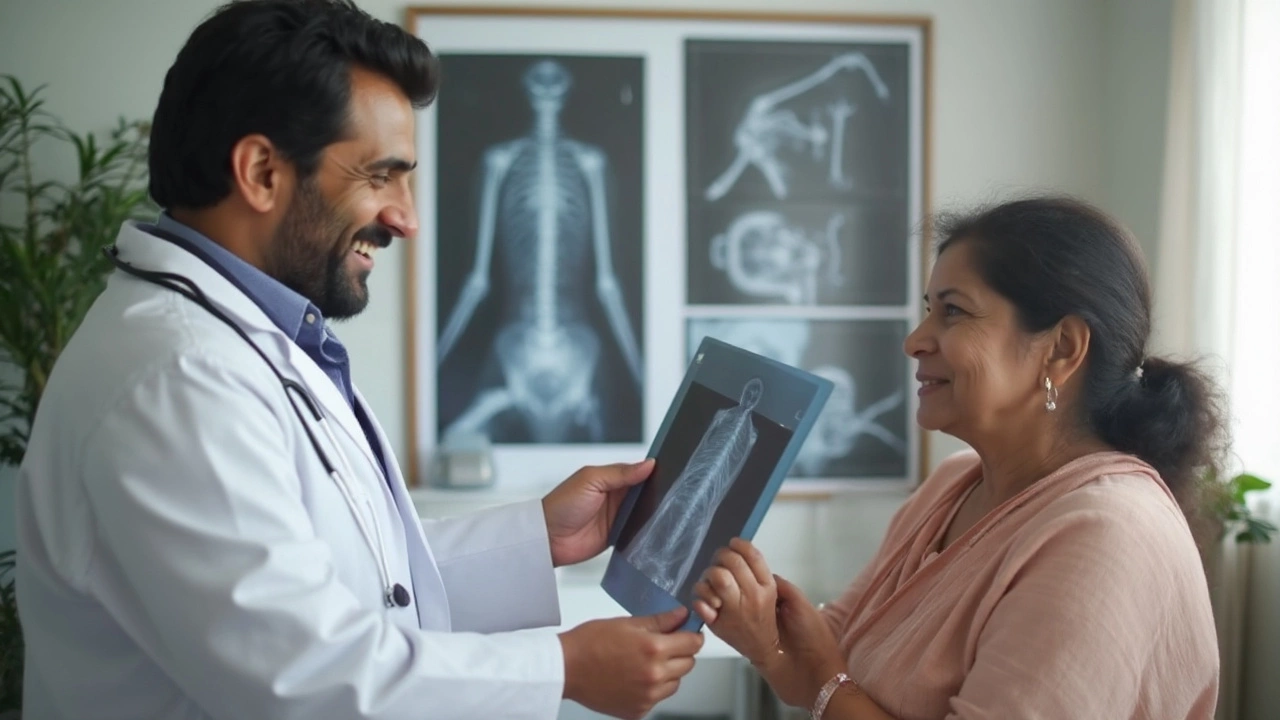
Most people show up to their first orthopedic appointment not knowing what to expect. The truth? The process is way more straightforward than you’d think. Surgeons don’t jump straight to complex medical talk—they want to understand you and your pain first.
When you check in, staff will probably hand you a bunch of forms—don’t rush through them. They’re not just paperwork; they help your surgeon tailor your visit to your needs. Bring your insurance info, any referrals, and a list of meds you take. Forgetting these slows everything down.
One solid tip: write down what bugs you the most before you go in. Is it sharp knee pain while you walk? Ankle swelling after jogging? Get specific. This helps your surgeon narrow down the cause and move faster toward a solution. Jotting down questions ahead of time keeps you from freezing up once the appointment kicks off. Trust me, you won’t remember everything you meant to ask if you don’t.
- The First Thing You’ll Notice at the Orthopedic Hospital
- What Questions Will the Surgeon Ask?
- The Physical Exam: What Really Happens
- Tests You Might Need: X-rays, MRIs, and More
- How to Get the Most Out of Your First Appointment
The First Thing You’ll Notice at the Orthopedic Hospital
Walk into an orthopedic hospital, and the first thing you’ll see is how much the place is set up for dealing with bone, joint, and muscle problems. Waiting rooms are usually loaded with educational posters about knee replacements, back pain, or joint care. It’s normal to spot folks wearing slings, boots, or even with ice packs strapped on. You’re definitely not alone if you’re limping in or having trouble moving around.
Check-in goes smoothly if you bring the right stuff. Here’s what you actually need every time you drop by:
- Your ID and insurance card.
- Any referral note your regular doctor gave you.
- A list of your medications and past surgeries.
- Relevant previous x-rays or test results if you have them.
Some places give you a quick pain scale chart right away—don’t just check “worst pain imaginable” unless it really is. Being honest about your symptoms helps everyone. About 70% of first appointments involve filling out a pain diagram, where you shade in exactly where things hurt or feel numb.
If you show up early, you might get through all the forms before your actual appointment time. Some clinics let you fill these out online the night before. That means less paperwork in the waiting room and less stress when you actually see the orthopedic surgeon.
Once you’ve checked in, you’ll notice staff trained to handle mobility issues. Doors are wide, hallways are clear, and many patients use crutches, canes, or walkers. Most hospitals also have wheelchair access everywhere—so there’s no shame in using what you need.
Here’s a handy breakdown of what most people bring or do at their first orthopedic surgeon visit:
| Item/Task | Why it Matters |
|---|---|
| ID & Insurance Card | Needed to confirm your coverage and identity |
| Referral from Regular Doctor | Often required for insurance or specialist visits |
| Medication List | Helps prevent drug interactions |
| Previous X-rays/Scans | Saves time and avoids duplicate tests |
| Pain Journal/Notes | Makes describing symptoms way easier |
Just being ready with the right info can knock a good 10-15 minutes off your appointment. And if you’re feeling nervous, know this: everyone here, from the receptionist to the doctor, sees dozens of first-timers every week. They expect questions and are used to helping patients get comfortable fast.
What Questions Will the Surgeon Ask?
The first visit to an orthopedic surgeon is all about figuring out your story, not just rushing to treatment. Expect the surgeon to ask specific questions that help them understand your pain or problem from every angle. They’re not being nosy—every answer helps rule things in or out, and keeps you safe.
They usually start with the basics and then get more detailed. Here are common questions you’ll hear:
- When did your pain or issue start?
- How bad is it, and does it come and go or stick around?
- What triggers it or makes it worse? For example, does it act up when you walk, climb stairs, or try to lift something?
- Did you injure yourself, or did the problem come out of nowhere?
- Have you tried things like rest, ice, pain medicine, or physical therapy already?
- Is the pain affecting your sleep, work, or hobbies?
- Any history of similar issues with other joints, or family members with joint problems?
- Do you have any other medical conditions, like diabetes or arthritis?
- Are you using any devices (braces, canes) because of the pain?
Sometimes, they’ll also ask how the problem affects your daily routine—like getting dressed, cooking, or playing sports. Be honest, even if you think the details are minor. The more the surgeon knows, the better the treatment plan.
About 7 out of 10 patients forget a detail about their symptoms or treatments if they don’t write it down, according to a survey by the American Academy of Orthopaedic Surgeons.
| Question Topic | Why It Matters |
|---|---|
| Start and Pattern of Pain | Helps spot injuries vs. gradual wear-and-tear |
| Previous Treatments Tried | Guides next steps, avoids repeating failed options |
| Impact on Daily Life | Shows how severe the problem really is |
| Family or Medical History | Some joint problems run in families or tie to other diseases |
The bottom line: There’s no such thing as too much information. The more details you give, the less guessing your orthopedic surgeon has to do. It’s a team effort—and you know your own body best.

The Physical Exam: What Really Happens
This is where your orthopedic surgeon is actually going to see what’s going on with your muscles, bones, and joints. Forget those cold, impersonal exams from TV dramas. What usually happens here is way more hands-on (and a lot less dramatic).
Your surgeon first checks out how you move. They’ll ask you to walk, bend, or maybe lift an arm or a leg. They’re watching for things like limping, weakness, or joint swelling—little clues that help pinpoint what’s wrong. Next, they’ll press or touch different spots to find exactly where it hurts. Don’t be shy about saying if something really stings. They’re not trying to cause pain; they need to know how your body reacts.
After checking your movement, your orthopedic surgeon might use simple tools—the reflex hammer comes out, fingers tap tendons, and sometimes you’ll squeeze or grip something to test your strength. It’s not a test you pass or fail—it’s about measuring baselines. Here’s a rundown of typical things that might happen:
- Checking how far you can move a joint (your “range of motion”)
- Testing muscle strength—can you push or pull against gentle resistance?
- Comparing one side of your body to the other for swelling or temperature
- Looking for redness, bruising, or changes in skin color
- Feeling for grinding, clicks, or pops as you move—sounds weird, but it’s helpful info
For context, a 2023 study found that more than 80% of orthopedic surgeon diagnoses started with careful physical exams—meaning most answers come from this basic check-up, before fancy scans even get involved.
If you have pain during any movement or touch, just say so. Being honest isn’t complaining—it gives them vital info to map out next steps. Want a pro tip? Wear loose, comfy clothes that make rolling up sleeves or pant legs easy. If you forget, you might be wrestling with skinny jeans when what you need is quick access for tests or checking your joints.
Tests You Might Need: X-rays, MRIs, and More
If it’s your first time seeing an orthopedic surgeon, you’re probably wondering if you’ll be sent for tests right away. The short answer? Usually, yes. X-rays are the usual first step. They give a quick and clear view of your bones so the doctor can spot fractures, arthritis damage, or any weird shapes that look off.
If your problem seems like it’s more about muscles, ligaments, or cartilage—not just about your bones—then your orthopedic surgeon might go for an MRI. These scans are great for soft tissue problems, like torn tendons or meniscus issues. Compared to an X-ray, getting an MRI takes longer and feels a bit like lying in a loud tube, but it does show a lot more detail. Not every problem needs an MRI though—you won’t be sent for one just for minor aches.
Other tests sometimes get thrown into the mix. CT scans offer better detail of complex bones, especially places like the spine or pelvis. Ultrasounds are handy for checking tendons near the skin’s surface, like on your shoulder or knee, and you get instant results. Blood tests aren’t common, but your doctor might order them if they suspect an infection or a condition like rheumatoid arthritis.
- X-rays: Best for checking bones, breaks, or arthritis.
- MRIs: Used when tissue or ligament injuries are in question.
- CT scans: Great for detailed images of complicated bone structures.
- Ultrasound: Quick and easy, checks soft tissue close to the skin.
- Blood tests: Ordered when infection or inflammation is suspected.
Here’s a quick look at how these tests stack up when it comes to common uses and how long they take:
| Test Type | Main Use | Time Needed |
|---|---|---|
| X-ray | Bones, breaks | 10-15 minutes |
| MRI | Soft tissues | 30-60 minutes |
| CT Scan | Complex bones | 15-30 minutes |
| Ultrasound | Tendons, cysts | 10-20 minutes |
| Blood Test | Arthritis, infection | 5-10 minutes |
Don’t worry if the orthopedic surgeon doesn’t call for every test right away. They usually stick to what gives them the info they need without overdoing it. If you ever feel confused about why a certain test is being done, ask. That’s what your visit is for.

How to Get the Most Out of Your First Appointment
Showing up to the orthopedic surgeon is only the first step. You want answers, options, and a clear plan. Here’s how you can make sure your first visit isn’t a wasted trip.
- Make a list of symptoms. Write down what hurts, when it starts, what makes it worse, and anything you’ve tried at home to fix it. Orthopedic pros appreciate detail—"My shoulder aches at night" is more useful than "My shoulder hurts."
- Load up on info. Bring your medical history—previous injuries, surgeries, and even stuff like allergies. Include a full list of medications, even vitamins or supplements. Some pain problems come from old injuries or meds you might forget about.
- Ask questions, even the obvious ones. Anything from "What does this mean for my daily life?" to "Will I need surgery?" Every orthopedic hospital doctor expects questions—don’t leave with doubts.
- Be honest about your lifestyle. Don’t pretend you don’t run marathons if you do, or skip the part about working a desk job. How you use your body matters for both diagnosis and treatment.
- Take notes during the chat. First visits can get overwhelming. Quick notes help you remember doctor instructions, possible next steps, or even how to take new meds.
Time is tight in most medical offices. You might get just 15-30 minutes, so staying organized is smart. Around 80% of patients forget some details after seeing their orthopedic surgeon—having stuff written down helps you beat those odds.
| What to Bring? | Why It's Important |
|---|---|
| Insurance card | Speeds up paperwork and billing |
| Photo ID | Confirms your identity |
| Referral (if needed) | Some insurance plans demand it |
| X-rays, MRIs, lab results | Keeps you from repeating tests |
| Medication/Allergy List | Avoids dangerous drug combos |
One last tip: if your pain flares in certain shoes, brings those in. Footwear and old braces can show a first visit doc what you’re dealing with every day. Thinking ahead isn’t just smart—it could cut weeks off your recovery.





Rohan Talvani
I am a manufacturing expert with over 15 years of experience in streamlining production processes and enhancing operational efficiency. My work often takes me into the technical nitty-gritty of production, but I have a keen interest in writing about medicine in India—an intersection of tradition and modern practices that captivates me. I strive to incorporate innovative approaches in everything I do, whether in my professional role or as an author. My passion for writing about health topics stems from a strong belief in knowledge sharing and its potential to bring about positive changes.
view all postsWrite a comment